Paratha Recipe
Updated: August 12, 2025, By Swasthi
Crispy flaky Paratha served with a curry is the best hearty & comfort meal. This 4 ingredient recipe helps you make basic Parathas at home in the simplest way. Chose the shape you prefer – triangle, square or round. This post also covers details to make ahead, store, freeze and reheat.
About Paratha
Paratha is a type of layered flatbread, staple all over India and South Asian countries. They are basically of 2 kinds – plain and stuffed. While the plain Parathas require just 4 basic ingredients like flour, salt, water and ghee/oil, the stuffed kind require a stuffing made with veggies or lentils, spices & herbs.
Basic plain Parathas come in 3 shapes – square, triangle and round. These are commonly made with whole wheat flour known as atta but you will often find the store bought frozen parathas being made with whole-meal, multigrain flour or only with all-purpose flour.
Some popular street style Parathas such as Mughali paratha and Kerala Malabar Parotta are made essentially with all-purpose flour known as maida. But for the everyday home-style healthier parathas, wheat flour is used because it is not refined and/or bleached like the all-purpose flour.
Making these basic flaky Parathas is easier than you think and they are great with any kind of curry, stew, pickle, chutney, fried eggs/ omelet, jam or with just chai. You may also use them to make wraps/ rolls. Here is what you need:
Whole wheat flour Vs all-purpose flour
Whole wheat flour is made from the whole wheat kernel so it makes the Paratha crisp, nutty, earthy and more flavorful. Whereas all-purpose flour is made from refined wheat grain (without the goodness of bran) so it produces a chewy, softer and lighter Paratha with a neutral flavor.
My Mom always made our Parathas with whole wheat flour (atta) because it’s healthier than all-purpose flour. So this is what I prefer. But if you want you may use organic or unbleached all-purpose flour for a chewy texture. Equal parts whole wheat flour and all-purpose flour works well too, without making your paratha too chewy. I have shown that in my Chicken Kathi Rolls.
Ghee vs Vegetable shortening (Dalda/Crisco)
Traditional households use puree ghee because it has a high smoke point and is great to fry the parathas. Ghee imparts a rich nutty flavor and is considered healthier than vegetable shortening. But you will often find the street shop and frozen parathas being made with vegetable shortening because it’s cheaper. If you can’t eat ghee, use any other cooking oil of choice.
Hot water vs warm water
Hot water denatures the protein in the flour, softens the bran and helps make tender/softer parathas. But if you like them crispy or plan to serve them hot, using warm or room temperature water is good enough. You can also use Indian buttermilk or yogurt whey to make the dough. The flavor of your parathas will be slightly different.
Salt & Sugar
Both are optional but many believe they balance the flavors. I don’t add sugar or salt in ours. If you want you may dissolve 2 tsps fine sugar in water, before using.
If you love flatbreads, you may love these
Kulcha (plain & stuffed)
Butter Naan
Chapati
Tandoori Roti
Photo Guide
How to make Plain Paratha (Stepwise photos)
1. Add 2½ cups (300 grams) wheat flour, ½ teaspoon salt & 1 tablespoon neutral oil to a mixing bowl (or food processor). Pour ¾ cup water & begin to form a soft non-sticky dough. Add more water as you mix the dough.
If you are using all-purpose flour start with 2/3 cup water.
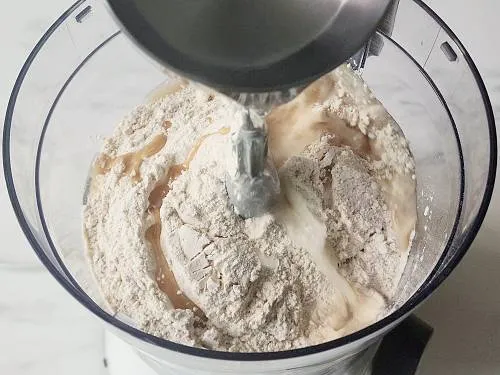
2. Knead/process until the dough is soft and pliable, for 3 mins. Add a few drops of oil over the dough and spread it all over. Cover and rest for 20 mins to 1 hour.
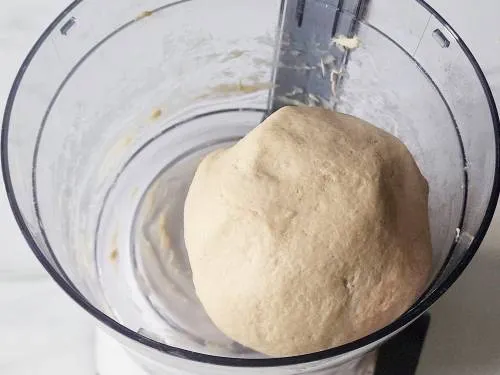
3. When you are ready to roll, divide the dough to 8 portions. Smoothen and roll them to balls in between your palms. Keep them covered all the time until the end. Add ¼ cup flour to a medium sized bowl & keep aside to roll the parathas.
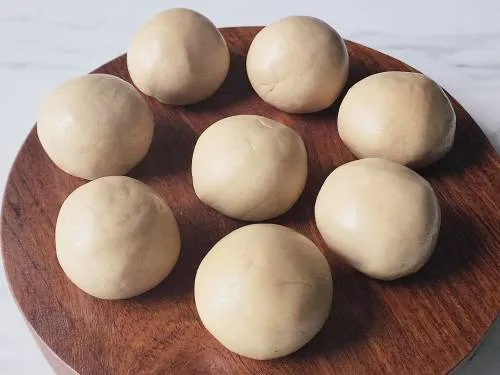
4. Sprinkle a teaspoon of flour on the rolling board or counter. Place a dough ball & flatten it with your fingers. Coat with flour on both the sides.
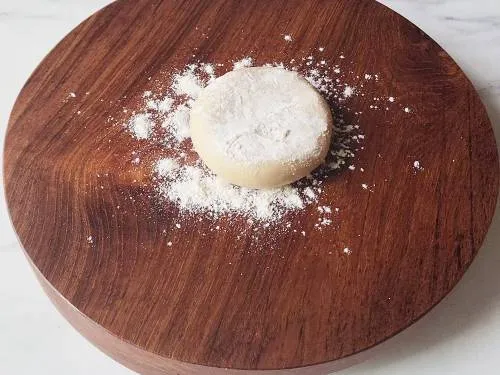
6. Roll to a 5 to 6 inch paratha. Apply ⅓ tsp melted ghee/ oil all over.
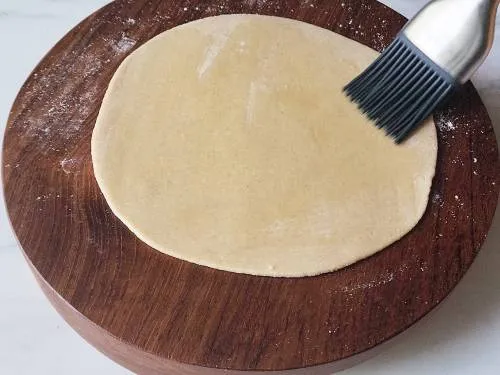
7. Sprinkle 2 pinches of flour.
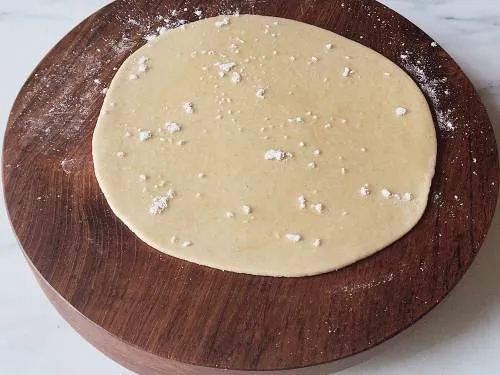
Square Parathas
8. Fold the left ⅓ part over the middle ⅓ as seen in the picture.
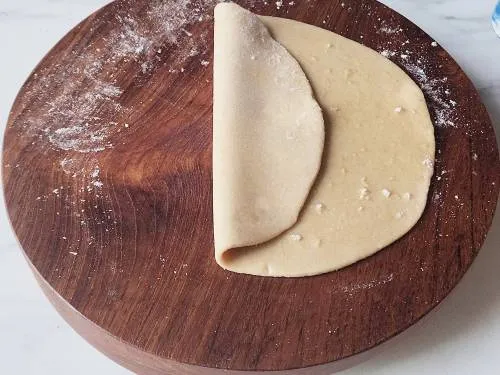
9. Fold the right ⅓ part over the middle. Apply a few drops of ghee all over the visible part & sprinkle a pinch of flour.
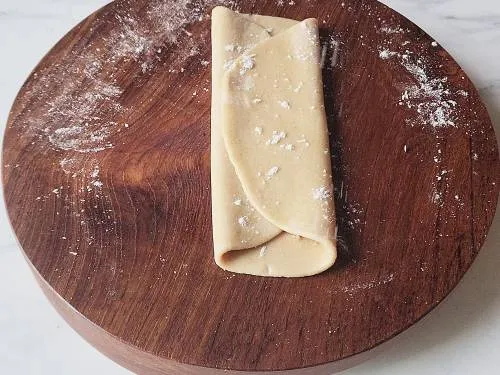
10. Fold the top ⅓ over the middle ⅓ and fold the bottom ⅓ over the middle, to get a square.
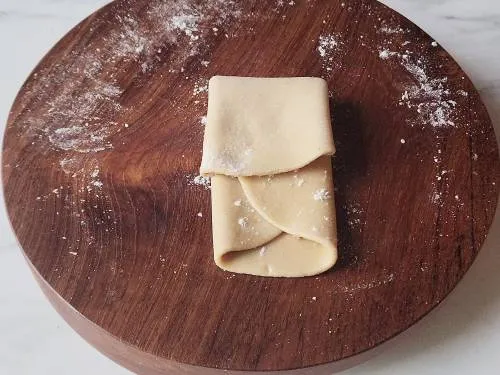
11. Sprinkle flour on both the sides lightly.
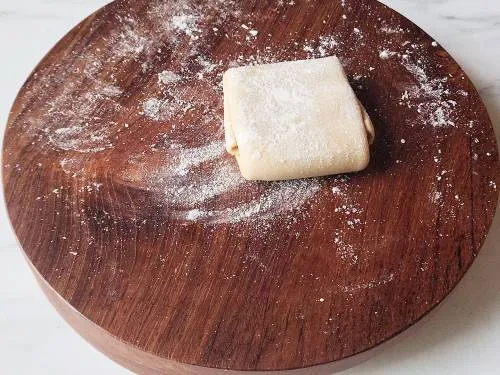
12. Roll to a 6 to 7 inch square paratha. You can make 4 to 5, before you fry them.
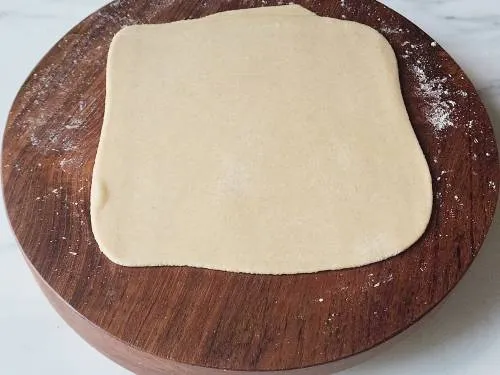
Triangle Parathas
13. Fold the round paratha to half, to make a semicircle. Apply ghee over the semicircle & sprinkle a pinch of flour.
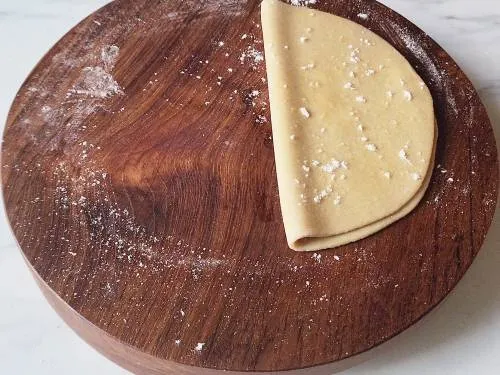
14. Fold it again to get a triangle. Roll this to a triable paratha.
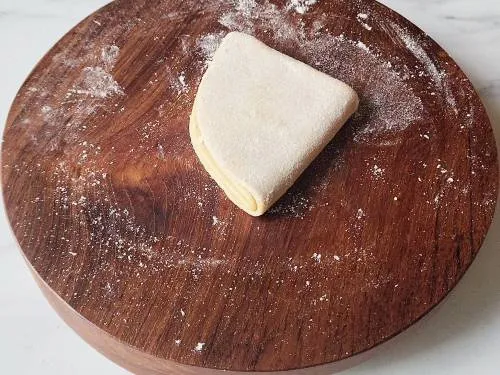
Round layered paratha
15. Spread a dough ball to a oblong roti. You can make it as long and as thin as you want. Spread ghee and sprinkle with flour.
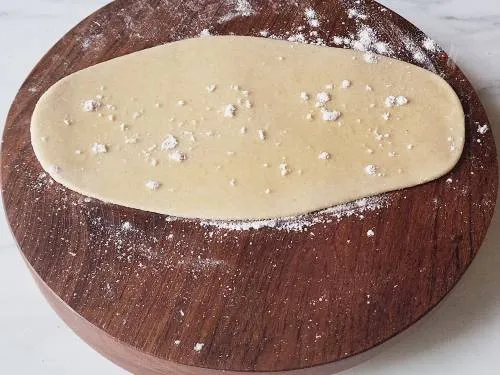
16. Begin to roll from one side to make a long roll or log.
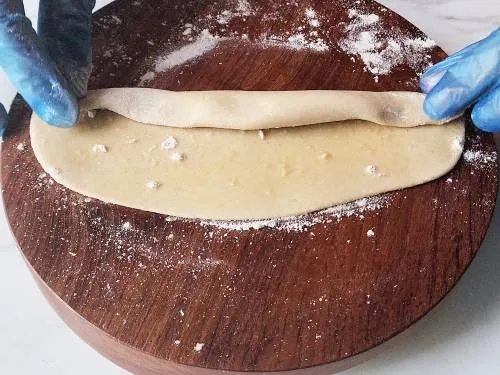
17. Pull it gently holding both the ends to stretch it as much as you can, without breaking. Begin to coil it from one end to the other.
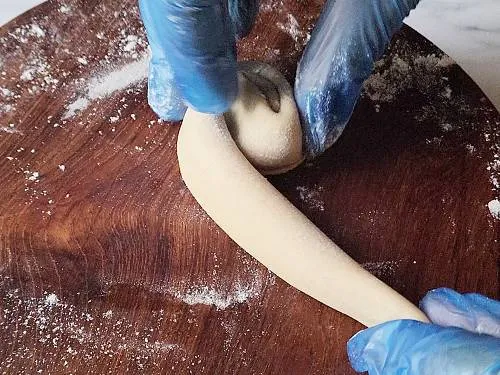
18. Tuck the end to the center. You should get a roll like seen in the image below.
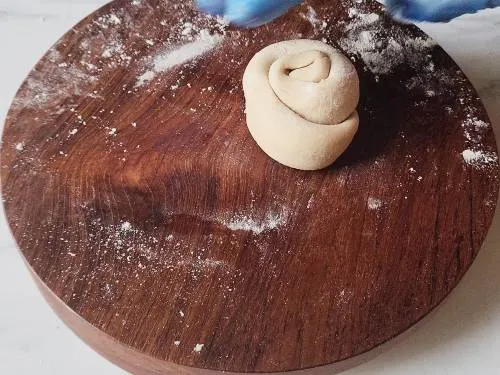
19. Roll this to a 6 to 7 inch round paratha.
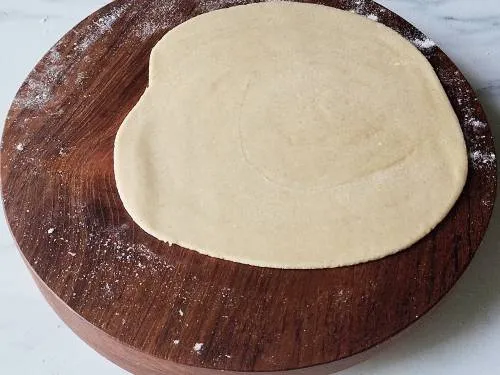
Frying Parathas
20. On a medium flame, heat a tawa/ pan until it’s medium hot. Dust off any excess flour from the paratha & transfer to the tawa.
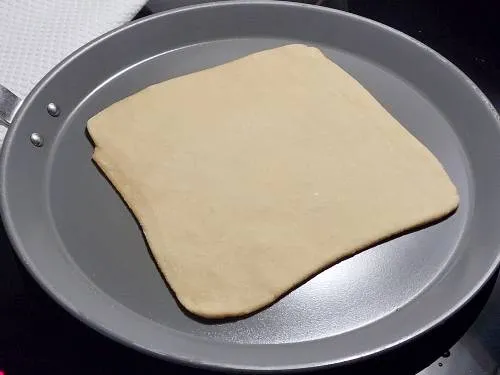
21. Turn it to the other side when you see few bubbles over the paratha (takes me about 40 to 60 seconds). Drizzle with ¼ teaspoon ghee. With a spatula spread the ghee gently all over. When it begins to puff (within a minute), turn it to the other side and drizzle more ghee.
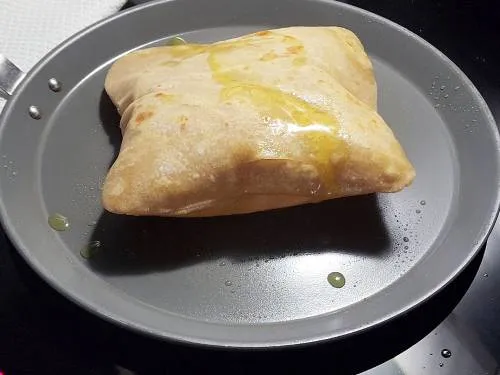
22. Press down gently with a spatula, until it puffs up and light brown spots appear. Press down on the edges to cook well. Remove and stack the parathas in a clean kitchen cloth lined in a casserole or on a wired rack. To fry the next paratha, make sure your pan is hot enough, but not very hot.
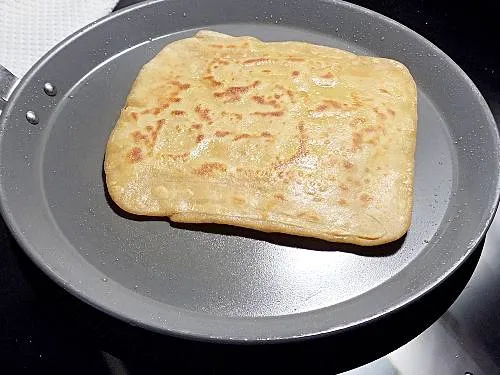
23. The same way fry the round parathas.
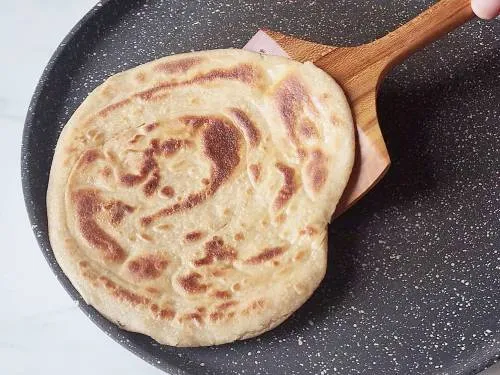
24. This is how your square parathas will look after frying.
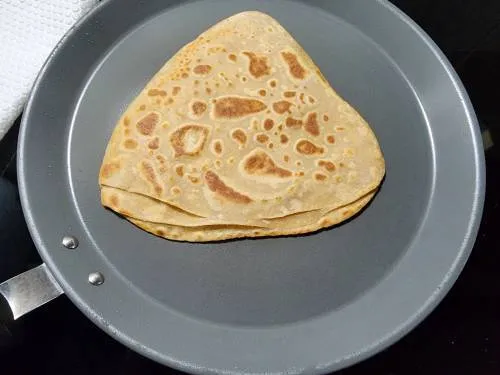
Serve parathas with your favorite curry. Store the leftovers in an airtight container and refrigerate up to 3 days. Heat up on a medium hot pan.
These parathas make for a great breakfast with egg bhurji or paneer bhurji. They also go well in the school and office lunch box. Here are some curries that go well –
Butter Chickpeas
Paneer butter masala
Dal tadka
Vegetable Jalfrezi
Vegetable curry
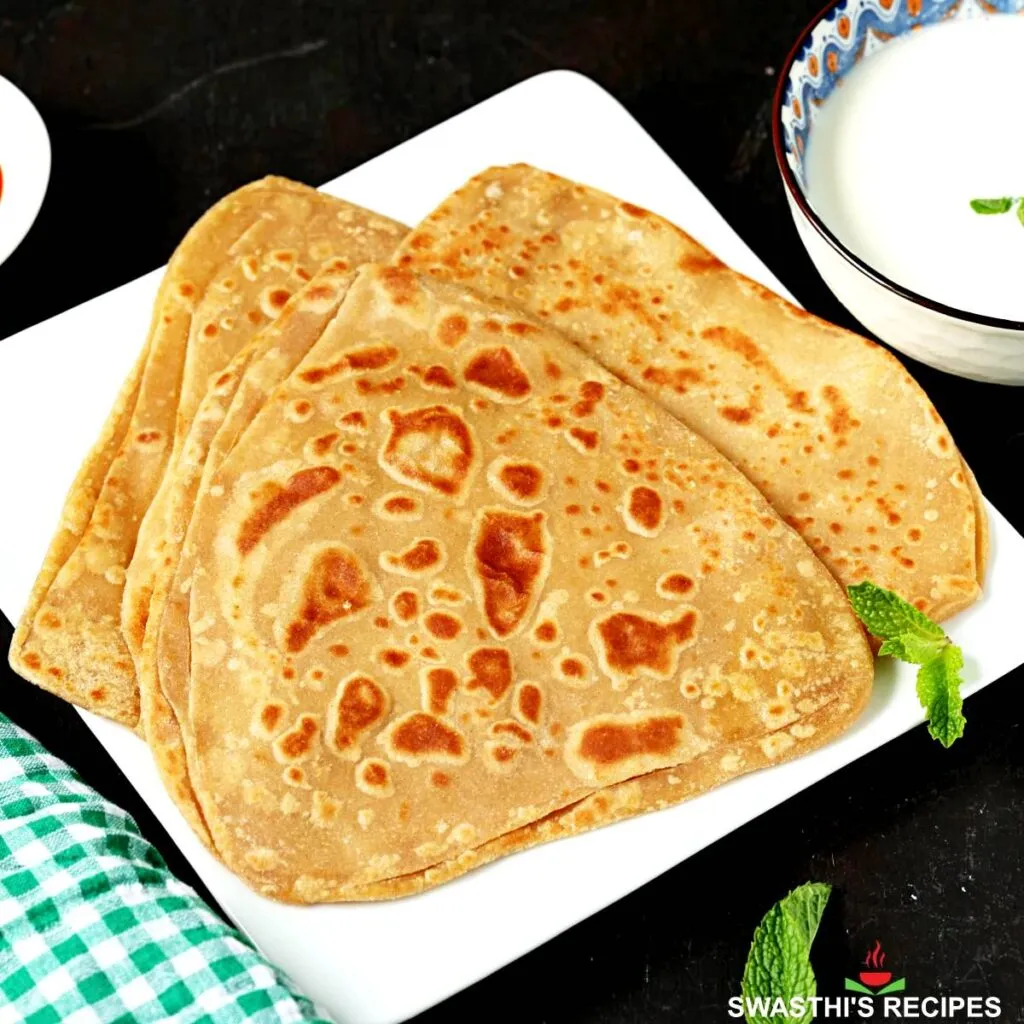
Expert Tips
- Water to dough ratio: I use 1 cup warm water to knead 2½ cups (300 g) atta or 2/3 cup + more, if using all-purpose flour. It may vary depending on the kind of flour. If your atta has too much bran, you will need more water. If the dough is dry or crumbly, add a splash of water as you knead. If it is sticky, add a spoon of flour and knead.
- Refrigerate the dough: You can make the dough ahead and refrigerate in an air tight container for 2 days. Bring it close to room temperature by resting on the counter for a few hours, before rolling.
- Rolling: Light-handed, even rolling helps them cook uniformly. Avoid rolling them too thick. They should be thin enough to cook inside but if they are too thin they won’t puff up or end up too crisp like papad.
- Freezing: Rolled parathas can be placed in between parchment papers and frozen. Thaw them only for a while before frying (until the paper loosens)
- Flame/heat: Avoid frying parathas on a low flame. They can turn hard and dry. Frying on a high heat can burn the outer layer and the inside may remain undercooked. So start with medium flame, and adjust the heat from there depending on the kind of stove, size of your burner and thickness of your pan.
- Storage: Store/refrigerate cooked parathas in an air tight container for 2 to 3 days. Cool them down completely before storing. Warm them up on a medium hot pan or in the instant pot (covered properly).
Related Recipes
Recipe Card
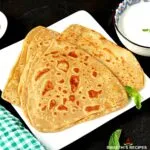
Paratha Recipe (Flaky South Asian Flatbread)
For best results follow the step-by-step photos above the recipe card
Ingredients (US cup = 240ml )
- 2½ cups (300 g) wheat flour (atta or sub with all-purpose flour + ¼ cup to roll)
- ¾ to 1 cup (180 to 240 ml) warm water (lesser if using all-purpose flour)
- ½ teaspoon salt + 2 tsps fine sugar (both optional)
- 1 tablespoon neutral oil to knead (I use refined coconut oil)
- 3 to 4 tablespoons (45 ml) melted ghee or oil to layer & fry
Instructions
Make dough
- Stir flour, salt & oil in a mixing bowl (or food processor). Pour water (start with lower amount) & mix to form a soft non-sticky dough, adding more water as required.
- Knead/process until the dough is soft and pliable, for 3 mins. Smear a few drops of oil, cover and let rest for 20 mins to 1 hour.
- Add ¼ cup flour to a medium sized plate or bowl & reserve aside to roll the parathas. Divide the dough to 8 portions. Smoothen and roll them to balls in between your palms. Keep covered until the end.
Roll paratha
- Sprinkle a tsp of flour over the rolling area and place the dough ball over it. Flatten it with fingers and coat with flour on both the sides.
- Roll to a 5 to 6 inch paratha. Apply ⅓ tsp melted ghee/ oil all over and sprinkle 2 pinches of flour all over.
- Triangle Parathas – Fold it to half, to make a semicircle. Apply ghee over the semicircle & sprinkle a pinch of flour. Fold it again to get a triangle.
- Square Parathas – Fold the left ⅓ part over the middle ⅓. Fold the right ⅓ part over the middle. Apply a few drops of ghee all over the visible part & sprinkle a pinch of flour. Fold the top ⅓ over the middle ⅓ and fold the bottom ⅓ over the middle, to get a square.
- Sprinkle flour on both the sides lightly and roll to a 6 to 7 inch square or triangle paratha. When you are done rolling 4 to 5, you may begin to fry.
Frying Parathas
- Heat a tawa/ pan on a medium flame, until it is medium hot. Dust off any excess flour from the paratha & transfer to the tawa.
- When you see bubbles on top (takes me about 40 to 60 seconds), turn it to the other side and drizzle with ¼ teaspoon ghee or oil. Gently spread the ghee all over with a spatula.
- When it begins to puff (within a minute), turn it to the other side and drizzle more ghee. Press down gently with the spatula, until it puffs and light brown spots appear. Press down on the edges to cook well.
- Remove and stack the parathas in a clean kitchen cloth lined in a casserole or on a wired rack. To fry the next paratha, make sure the pan is hot enough, but not smoking hot.
- Serve parathas with your favorite curry. Store the leftovers in an airtight container and refrigerate up to 3 days. Heat up on a medium hot pan.
Notes
- I use 1 cup warm water to make the dough. It may vary depending on the kind of flour. If your atta has too much bran, you will need more water.
- If using all-purpose flour, start with lesser water 2/3 cup and add more as required.
- Using too much flour while rolling can make your parathas floury, hard and dry.
- You can make the dough ahead and refrigerate in an air tight container for 2 days. Bring it close to room temperature before rolling.
- If you have solid ghee, melt it before using. This way it is easier to control the amount.
- You can also use melted unsalted butter to brush while layering. This produces softer parathas.
Video
NUTRITION INFO (estimation only)
© Swasthi’s Recipes
This post was originally published in Feb 2016. Updated in August 2025.
About Swasthi
I’m Swasthi Shreekanth, the recipe developer, food photographer & food writer behind Swasthi’s Recipes. My aim is to help you cook great Indian food with my time-tested recipes. After 2 decades of experience in practical Indian cooking I started this blog to help people cook better & more often at home. Whether you are a novice or an experienced cook I am sure Swasthi’s Recipes will assist you to enhance your cooking skills. More about me
Follow Swasthi’s Recipes
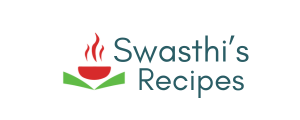
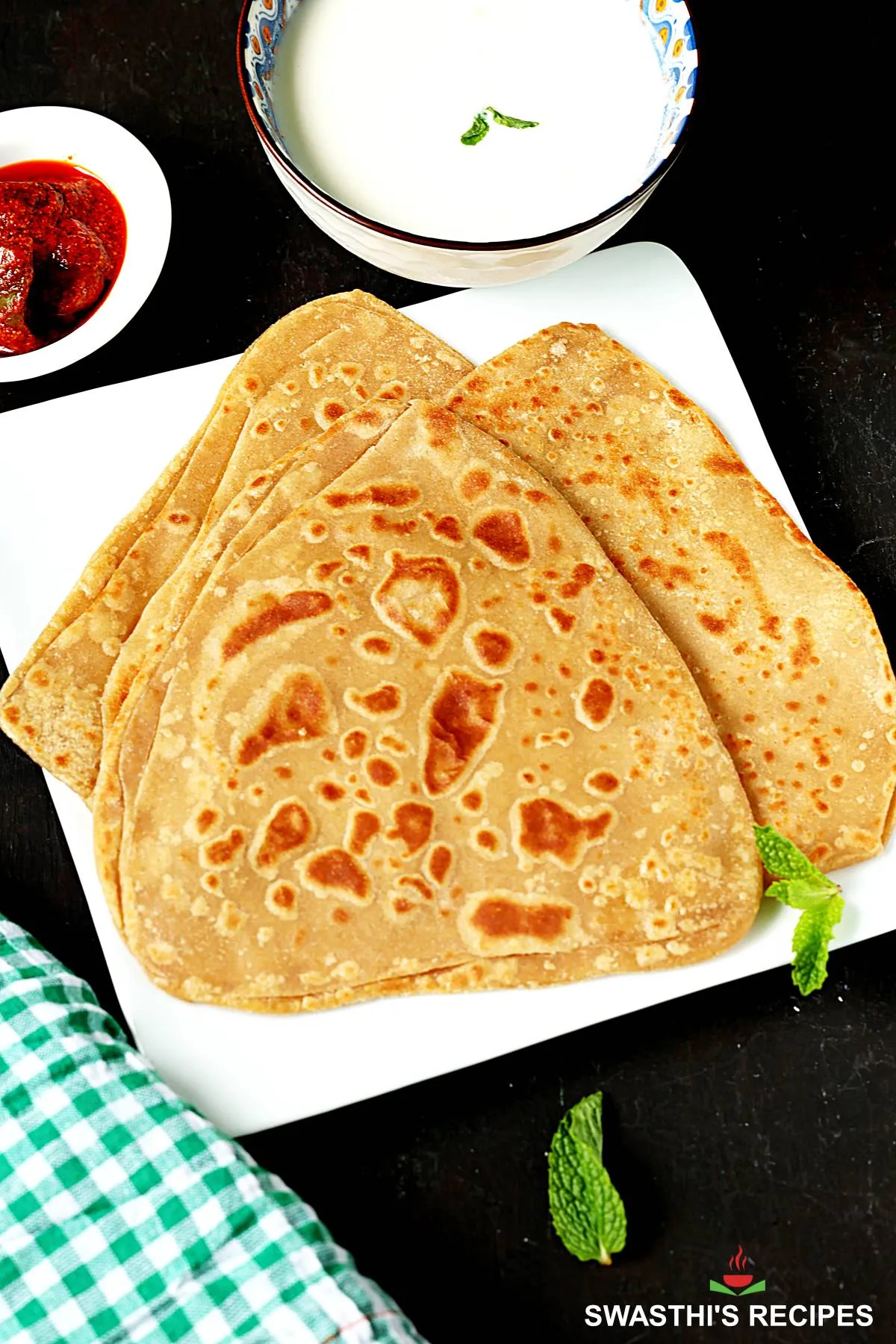

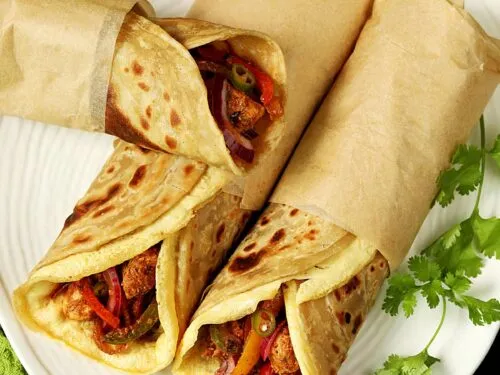
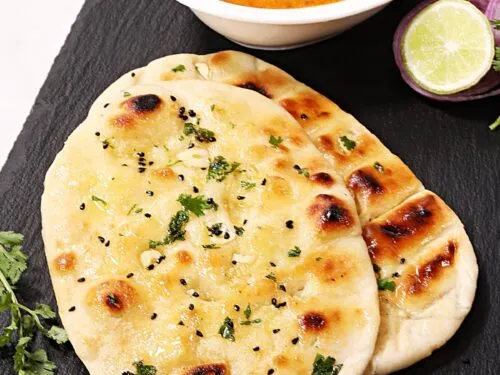
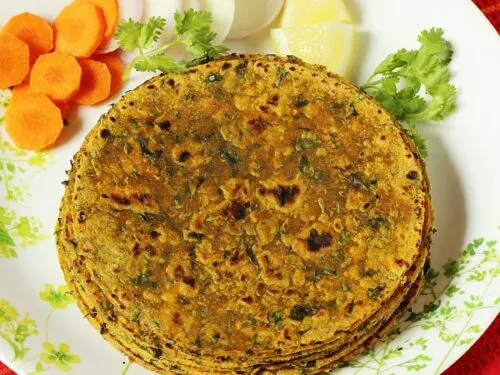
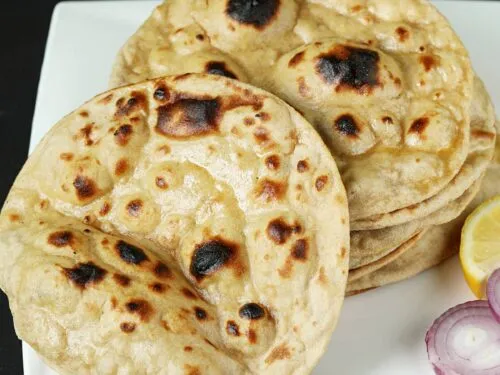
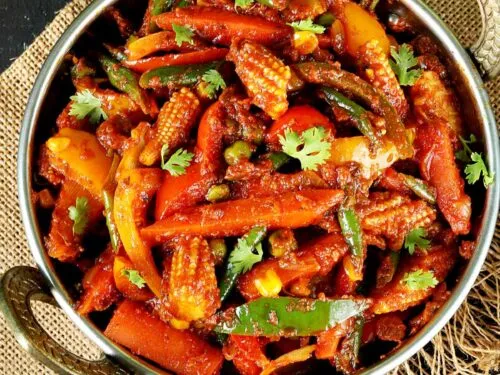
Comments
Swasthi does such great recipes. I am not a great cook and these recipes come out 100% every time. My kids love these parathas
I made these with 2/3 all purpose and 1/3 whole grain spelt flour – turned out great, with easily separable layers. What helped me a lot was the note on heating the pan just enough, but not too much. Sometimes recipes call for maximum heat, but that can damage the pan – now I’ll know that’s not necessary when cooking such flatbreads.
Superb
I made these parathas with all-purpose flour because the nearest place to buy atta is 20 miles away. The results were amazing! They were soft from inside and flaky on the outside but I had to double the amount of oil. Not knowing what kind of oil to use I went ahead with virgin coconut oil. What oil do people use traditionally? Is coconut oil alright?
Next time I would double because they stored well in the refrigerator for 4 days. My wife loved them with fried eggs and gauco for her breakfast. Thank you for the pictures they helped a lot
My pleasure Caleb! Glad the recipe helped. Traditionally ghee is used to fry parathas. But you can use any kind of oil that suits your dietary needs. My personal experience is that any unrefined/ virgin oil will begin to smoke up if you cook the parathas on a medium high to high heat. It’s alright if you know how to regulate the heat & prevent the smoke. Virgin coconut oil is okay to use if you like the flavor and avoid adding it right at the beginning of frying. Add it during the last 1 to 2 mins. Thank you so much for sharing back.
can you eat it with potatoe rice
Yes you can. Usually they are served with a vegetable curry, dal or pickle and yogurt. You can also eat it with scrambled eggs or omelette
can you use mandazi flour if I do not have that flour
Yes you can use it
Can you only cook part of the dough and save some for another day?
Yes you can. They can also be frozen that way and finished while reheating
Learnt making parathas from your website. But you didn’t show us the malabar style round layered paratha. I would love to try them for my kids.
Thanks Gauri. Yes sure I will share it
Yummy! Going to try to make them.
Hope you enjoy Rosanna.
Just to say thank you Swasthi for all your recipes. Your website is extremely detailed which helps a lot to learn to cook Indian💞
You are most welcome Daisy. Very glad to read that!
These parathas were delicious and much easier to make than the recipes I tried earlier. I used extra ghee to cook them. They were flaky on the outside and soft from inside. The photos were very helpful. Keep up the great work
Thanks for trying and sharing back Linda. So happy you like the parathas
Thanks for the recipe you all have to offer.Thanks so much.
You are welcome George
Lovely and delicious
Thank you
Wow so easy i will try mine
Thanks Mariyam
I used butter to spread in between the layers and my parathas were so soft from inside. Delicious and tasty! I learn something new every time from your recipes. I made 3x to eat through out the week. But how do you reheat?
Thanks Divya, that’s nice to know! I reheat in the IP for 0 to 3 mins, depending on how cold the parathas are. You can also reheat them in a steamer, in the microwave for 30 seconds or on the tawa. Steamer and IP gives me better soft results
Is that in the instant pot on saute mode? Thank you🙏
Hi Grace,
I refrigerate them in a steel container with a tight lid and to reheat I put it in the IP, over the trivet. Hope this helps
These are absolutely the best Indian parathas I’ve ever eaten!! My family loved them with your chicken korma. We doubled the recipe for a larger batch and they were even more delicious the next day in your kothu paratha made with your vegetable kurma. Thank you for bringing authentic dishes to our table.
Thank you so much Sue. So happy to read this. Love the way you used these paratha to make kothu!
I love your recipes! Is there anyway to change measurements to metric? ☺️
Thank you! I have done it for many recipes but still many more to do. I can help you whenever required. You may just drop a comment.
Nice
You are amazing. This is so thorough. I am enjoying your recipes.
Thank you so much Angela!
I saw your recipe and made for my baby. First finger food. First memories. There were tears in my eyes as my baby ate happily. It turned out so well. Thanks for the recipe
Amu, That’s great! So glad the recipe helped! Thank you for sharing back.
can paratha be made with all purpose flour?
Paratha is always made with wheat flour and not with all-purpose flour. There is another kind of flatbread that is made with all-purpose flour and it is known as parotta, not paratha